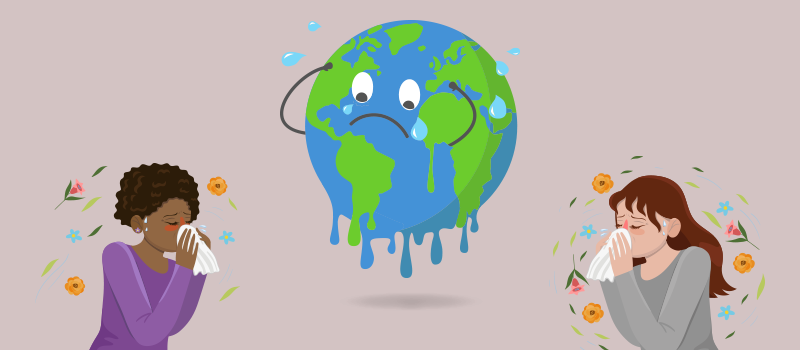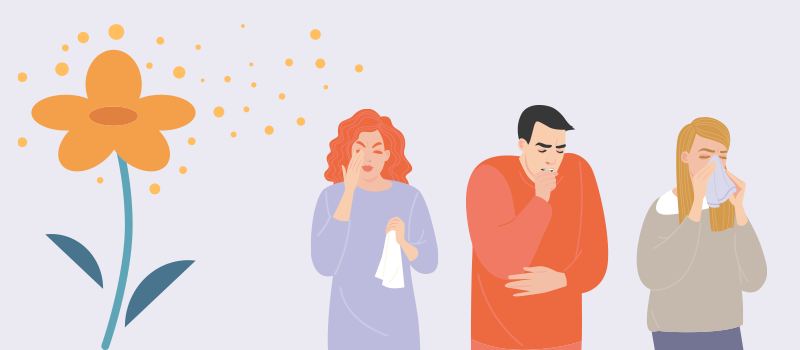What’s the Buzz
The Bee Healthy Blog
Does Climate Change Impact Allergies?

Nearly 20 million Americans suffer from pollen allergies[1], and over the past few decades, the prevalence of allergies amongst Americans has dramatically increased. In 1970, about one in ten people suffered from seasonal allergies, also known as hay fever, which is caused by airborne allergens, such as pollen and mold spores. By 2000, the number of people with seasonal allergies skyrocketed to three in ten. One theory as to why this is the case is climate change and global warming.
Pollen is an airborne allergen composed of microscopic grains dispersed from flowering plants, trees, grass, and weeds. The amount and type of pollen in the air depend on the season and geographic region. Though pollen counts are typically higher during the warmer seasons, some plants pollinate year-round[2]. Analysis of local temperature data by Climate Central and recent scientific research shows that climate change is prolonging the season of suffering for people with allergies[1].
Earlier spring, shorter winters
Climate change has already led to earlier springs and later winters, which means a longer growing season for plants that make pollen. A study of 60 pollen-collecting stations in the U.S. and Canada found that pollen season is now 20 days longer on average than it was in 1990, resulting in a rise of allergic asthma and seasonal hay fever. One study found that in 2000, annual pollen production began on April 14 and peaked on May 1, but that in 2040, pollen levels are predicted to peak as early as April 8[3].
What does climate change have to do with allergies?
Burning fossil fuels releases carbon pollution into the atmosphere that warms the planet and drives climate change. The air pollution and warmer temperatures are extending the freeze-free season, giving plants more time to grow, flower, and produce more pollen[3]. As atmospheric carbon dioxide (CO2) levels rise, laboratory experiments suggest, some plants that produce allergenic pollen produce even more of it[1]. Scientists predict that average pollen counts in 2040 will be more than double what they were in 2000[3].
Pollen counts have been increasing over the last 20+ years in the United States at least in part due to higher temperatures and higher levels of carbon dioxide in the air. Burning fossil fuels also releases air pollutants and air particles that can make allergy symptoms worse, and in some cases cause asthma. Reducing fossil fuels can have the double benefit of slowing climate change and reducing allergy symptoms and asthma attacks that are triggered by allergies[3].
Asthma cases on the rise
Asthma—which often occurs alongside pollen allergies—has become more common, too. The proportion of Americans who suffer from asthma rose from 3.1 percent to 8.4 percent of the population between 1980 and 2010. Rates are even higher among African-Americans, low-income households, and children. Today, about 6.2 million Americans under the age of 18 suffer from the chronic disease[1]. In 2013, the U.S. Environmental Protection Agency reported that asthma had become a national epidemic affecting 56 million, or one in every 23 people. With increased air pollution creating increasingly worse air quality, especially in urban areas, it’s no surprise that people are suffering the health effects.
A public health issue
Doctors and scientists expect conditions to worsen unless we stop the increase of carbon dioxide emissions that have been linked to climate change. More people are suffering from itchy eyes, runny nose, coughing, congestion, and shortness of breath. They can’t focus at school or work and have trouble sleeping as a result. These increased environmental triggers have also led to more adults plagued with allergies later in life. In the past, someone may have been genetically predisposed but symptoms never expressed themselves because exposure to allergens never hit a critical mass.
Tips for managing allergy symptoms
If you do suffer from allergies, here are some tips on natural and effective methods for managing your symptoms:
- Use saline nasal rinses to flush out allergens from sinuses. The saltwater solution will wash away irritants.
- Use a cool-mist humidifier to help remove allergens out of the air. They will bind to water droplets and fall to the ground instead of being inhaled.
- Remove pollen and spores from the air using an air purifier with a HEPA filter. The bedroom is the best location for this machine if you only have one.
- Keep your immune system well balanced with probiotics. Choose yogurts that contain Acidophilus, Lactobacillus rhamnosus GG, and Bifidobacterium lactis.
- Acupuncture can calm an overactive immune system that causes bad allergy symptoms. Try to start treatment about a month before your peak season.
We can’t always avoid the allergens in our environment, but we can try to manage how much the irritants impact our daily productivity. We can also do our part by being environmentally conscious and taking personal steps to help reduce our carbon footprints. Remember, BuzzRx can help you save on allergy medications—both prescription and over-the-counter, as long as you have a signed prescription from your doctor.
[1] https://www.climatecentral.org/climate-matters/pollen-allergy-season
[2] https://www.cdc.gov/climateandhealth/effects/allergen.htm
[3] https://www.hsph.harvard.edu/c-change/subtopics/climate-change-and-allergies/











SOCIAL